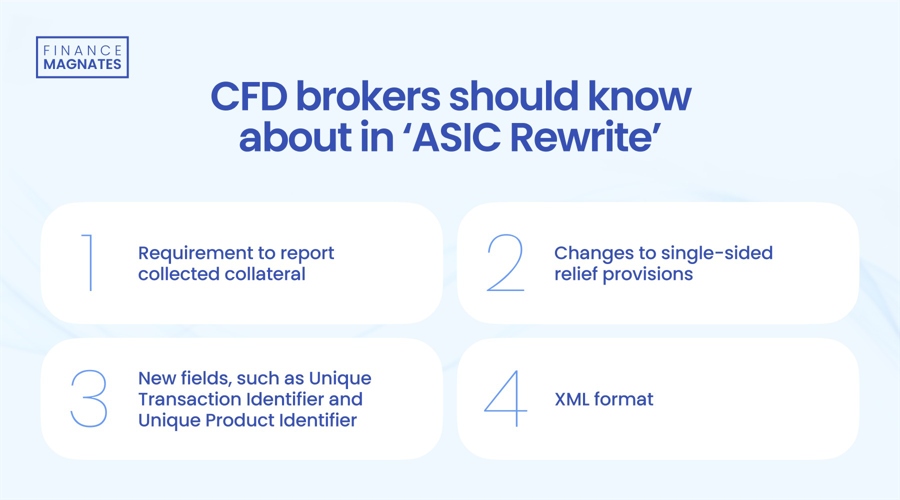Australian
CFD brokers are bracing for significant changes to their reporting obligations
as the Australian Securities and Investments Commission (ASIC) finalizes its
“ASIC Rewrite” of OTC derivative reporting rules, set to commence today
(Monday).
CFD Brokers Face New
Reporting Requirements as ASIC Rewrite Looms
The new
rules, which have been years in the making, will introduce sweeping changes to
how CFD brokers report transactions and manage client data. Key updates include
the requirement to report collected collateral, new unique identifier fields,
and a shift to XML formatting.
What is changing for CFD
brokers?
- Expanded
collateral reporting:
Brokers must now report margin received from clients, not just margin posted to
hedging counterparties. This provides regulators with a more comprehensive view
of collateral flows. - Revised
single-sided reporting rules: The framework for single-sided reporting relief has been updated,
potentially affecting how some trades are reported. - New
identifier fields:
The introduction of Unique Transaction Identifiers (UTIs) and Unique Product
Identifiers (UPIs) aims to improve trade matching and product classification
across the industry. - Standardized
data format:
Reports must now be submitted in XML format, promoting consistency and easier
data processing.
“The
ASIC Rewrite will bring many major and minor reporting changes for CFDs brokers,”
said Sophie Gerber, co-CEO of TRAction Fintech. “Previously, reporting
entities (such as CFD brokers) only had to report collateral that was ‘posted.’
Now, they will also have to report collateral received.”
Gerber
highlighted that the implementation is staggered, with the bulk of changes
coming into effect now, followed by additional requirements in October 2025:
- 21
October 2024 – UPI, UTI, XML format, and the
country of counterparty 2. - 20
October 2025 –
Removing the “alternative reporting” framework, requiring ASIC-regulated firms
to report trades with foreign firms, regardless of the foreign firm’s reporting
obligations. Reporting must be submitted to ASIC-authorized repositories to
qualify for compliance relief.
“CFD
brokers should consider the changes, particularly the impact of the additional
requirement to report collected collateral in relation to derivatives on behalf
of their clients,” Gerber advised. “Whether this will be strenuous on
the business and require additional resourcing, along with the timing of the
two implementation dates, should be carefully considered.”
What are UTIs and UPIs?
The ASIC
Rewrite introduces new concepts such as Unique Transaction Identifiers (UTIs)
and Unique Product Identifiers (UPIs), aligning Australian reporting standards
more closely with global practices.
UTIs
UTIs are
like unique barcodes for individual derivatives transactions. They allow
regulators and market participants to identify and track specific trades across
different systems and institutions. UTIs help prevent double-counting of trades
and make it easier to reconcile trade data. When a derivatives trade is
executed, it is assigned a UTI – typically a long alphanumeric code. This UTI
stays with the trade throughout its lifecycle, allowing it to be tracked even
if it is modified or transferred between parties.
UPIs
UPIs are
standardized codes that identify specific types of derivatives products. They
provide a consistent way to classify and identify the particular product being
traded, such as a certain type of interest rate swap or credit default swap.
UPIs are
typically shorter codes that represent the key characteristics of a derivatives
product. By using UPIs, regulators and market participants can more easily
analyze market activity and risk across comparable products, even when those
products are traded on different platforms or in different jurisdictions.
To Sum Up
UTIs
identify specific trades, while UPIs identify what type of product was traded.
Together, these identifiers help create a more organized and transparent
derivatives market by providing consistent ways to label and track trades and
products across different institutions and jurisdictions.
As the
October 2024 deadline approached, ASIC
provided further guidance to help firms transition to the new reporting
regime.
This article was written by Damian Chmiel at www.financemagnates.com.
Source link



